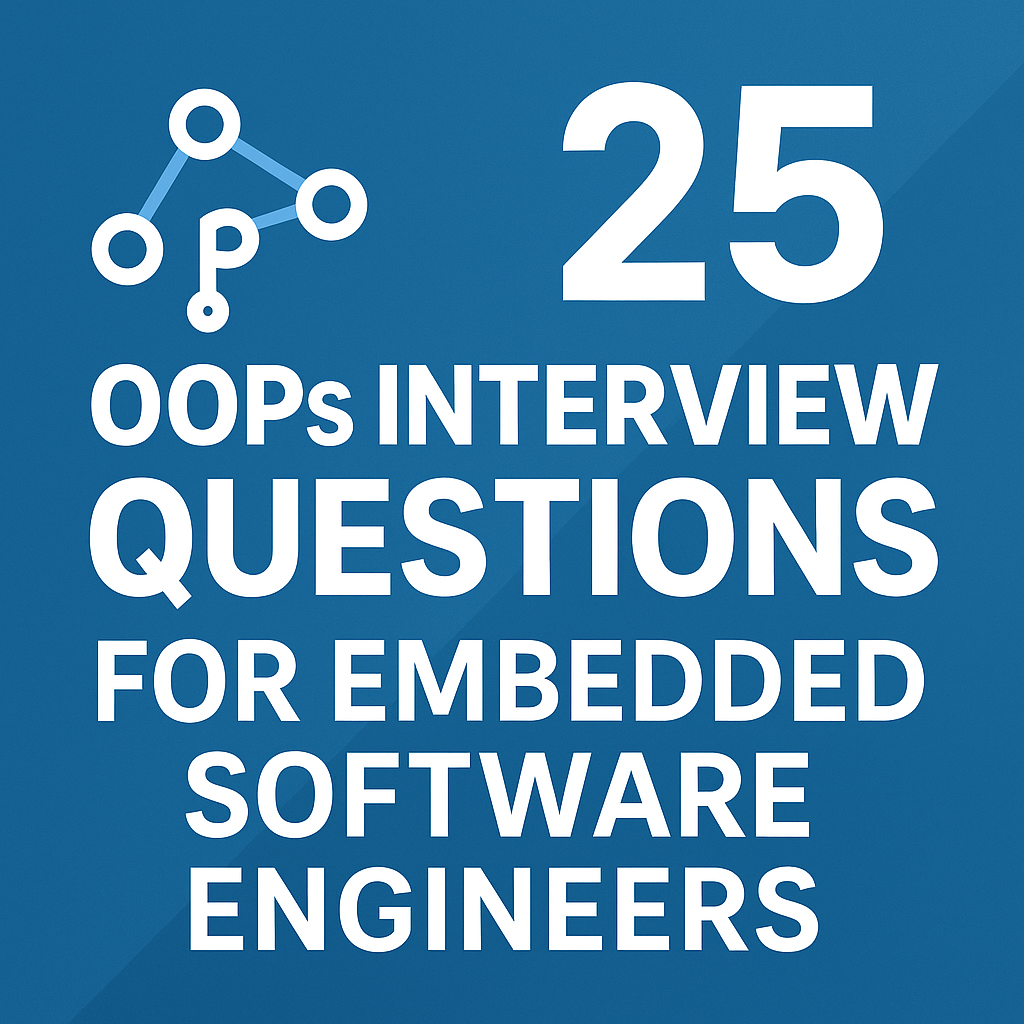25 OOPs Interview Questions : Are you preparing for your next Embedded Software Engineer interview? A strong foundation in Object-Oriented Programming (OOPs) is critical, especially when working in C++ for embedded systems. In this article, we will explore 25 frequently asked OOPs interview questions, each explained in-depth with examples tailored for embedded systems. These questions are crafted to help you crack interviews at companies like Bosch, Continental, KPIT, Qualcomm, and more.
25 OOPs Interview Questions
Why OOPs in Embedded Software?
Object-Oriented Programming helps embedded developers to:
- Organize complex code
- Promote reusability and modularity
- Simplify maintenance and debugging
- Support real-time performance with modern C++ features
Top 25 OOPs Interview Questions for Embedded Software Engineers
1. What is Object-Oriented Programming (OOP)?
Object-Oriented Programming is a programming paradigm based on the concept of objects. Each object is an instance of a class, which encapsulates data and functions. OOP promotes reusability, modularity, and encapsulation — all essential for embedded systems where code efficiency and scalability matter.
2. What are the main principles of OOP?
There are four major principles:
- Encapsulation: Hides internal details, exposes functionality
- Abstraction: Shows only essential features
- Inheritance: Reuses code across similar classes
- Polymorphism: Allows function overloading and overriding
3. How is OOP different in embedded systems compared to desktop systems?
Embedded systems have limited memory and processing power, so OOP features must be used judiciously. For example, virtual functions and dynamic memory allocation can impact performance and are often avoided or replaced with static polymorphism (CRTP).
4. What is a class and object?
- Class: A blueprint defining data members and member functions
- Object: A runtime instance of a class
class LED {
int pin;
public:
LED(int p): pin(p) {}
void on() { digitalWrite(pin, HIGH); }
};
LED led1(13);
5. What is encapsulation? How is it useful in embedded?
Encapsulation hides implementation details, making code safer and modular. In embedded systems, it helps to limit direct hardware access and prevent bugs.
6. Explain access specifiers: public, private, protected
public: Accessible from anywhereprivate: Accessible only within the classprotected: Accessible in class and its derived classes
7. What is constructor and destructor in C++?
- Constructor: Automatically invoked when an object is created
- Destructor: Automatically called when object goes out of scope
Used in embedded for initializing hardware and releasing resources.
8. What is constructor overloading?
You can define multiple constructors with different parameters:
class Timer {
public:
Timer() {}
Timer(int delay) { /* Init with delay */ }
};
9. What is a copy constructor?
It creates a copy of an object. Useful in embedded when passing objects by value.
10. What is inheritance and how is it used?
Inheritance allows creating new classes from existing ones, improving code reuse.
class Sensor { /* Base */ };
class TempSensor: public Sensor { /* Derived */ };
11. What is function overloading vs overriding?
- Overloading: Same function name, different parameters
- Overriding: Redefining a base class method in a derived class using
virtual
12. What are virtual functions?
Used for runtime polymorphism. In embedded systems, they should be used cautiously due to the added vtable overhead.
13. What is pure virtual function and abstract class?
A pure virtual function makes a class abstract. It’s used to enforce interfaces.
class Interface {
public:
virtual void init() = 0;
};
14. What is static polymorphism?
Also known as compile-time polymorphism, achieved using templates or function overloading. Preferred in embedded to avoid runtime overhead.
15. What are friend functions and classes?
They bypass encapsulation. Use only when needed in embedded code to access private data (e.g., during low-level hardware debugging).
16. What is the ‘this’ pointer?
Points to the current object. Used for object chaining or distinguishing between member and local variables.
17. What are static data members and static functions?
- Shared across all objects
- Useful in embedded for tracking hardware state or shared resources
18. What is the difference between composition and inheritance?
- Inheritance: “is-a” relationship
- Composition: “has-a” relationship
Prefer composition in embedded to keep class hierarchy shallow and manageable.
19. What is multiple inheritance and why is it risky?
A class inherits from more than one base class. Risky in embedded due to ambiguity and complexity. Use interfaces or composition instead.
20. What is object slicing?
Occurs when an object of a derived class is assigned to a base class object, losing the derived part. Avoid this in embedded systems by using pointers or references.
21. What is the role of constructors in embedded hardware abstraction?
Constructors are used to initialize hardware resources, such as pins, registers, or peripherals, when objects are created.
22. How do you implement state machines using OOPs in embedded systems?
Using inheritance and polymorphism, each state can be a class, and transitions can be managed via function calls — clean and scalable.
23. What is CRTP (Curiously Recurring Template Pattern)?
Used in embedded systems for static polymorphism without runtime cost.
template<typename Derived>
class Base {
void doSomething() {
static_cast<Derived*>(this)->impl();
}
};
24. How does OOP help in hardware abstraction?
You can abstract hardware modules (UART, SPI, ADC) as classes with clean interfaces. This decouples application logic from hardware-specific code.
25. What OOP features should be avoided or used carefully in embedded C++?
Avoid:
- Heap allocation (
new,delete) - Virtual functions in performance-critical paths
- RTTI and exceptions (not always supported in embedded toolchains)
Final Thoughts
Understanding OOPs concepts in C++ for embedded systems is vital to writing clean, maintainable, and scalable code. While embedded software places some constraints on typical OOP usage, modern C++ (especially C++17 and C++20) enables powerful yet efficient patterns suitable for real-time applications.
If you are preparing for an embedded systems interview, these 25 OOPs interview questions will strengthen your understanding and help you ace your technical rounds.
You can also Visit other tutorials of Embedded Prep
- Multithreading in C++
- Multithreading Interview Questions
- Multithreading in Operating System
- Multithreading in Java
- POSIX Threads pthread Beginner’s Guide in C/C++
- Speed Up Code using Multithreading
- Limitations of Multithreading
- Common Issues in Multithreading
- Multithreading Program with One Thread for Addition and One for Multiplication
- Advantage of Multithreading
- Disadvantages of Multithreading
- Applications of Multithreading: How Multithreading Makes Modern Software Faster and Smarter”

Mr. Raj Kumar is a highly experienced Technical Content Engineer with 7 years of dedicated expertise in the intricate field of embedded systems. At Embedded Prep, Raj is at the forefront of creating and curating high-quality technical content designed to educate and empower aspiring and seasoned professionals in the embedded domain.
Throughout his career, Raj has honed a unique skill set that bridges the gap between deep technical understanding and effective communication. His work encompasses a wide range of educational materials, including in-depth tutorials, practical guides, course modules, and insightful articles focused on embedded hardware and software solutions. He possesses a strong grasp of embedded architectures, microcontrollers, real-time operating systems (RTOS), firmware development, and various communication protocols relevant to the embedded industry.
Raj is adept at collaborating closely with subject matter experts, engineers, and instructional designers to ensure the accuracy, completeness, and pedagogical effectiveness of the content. His meticulous attention to detail and commitment to clarity are instrumental in transforming complex embedded concepts into easily digestible and engaging learning experiences. At Embedded Prep, he plays a crucial role in building a robust knowledge base that helps learners master the complexities of embedded technologies.


Leave a Reply